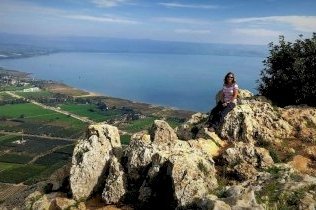Israel
Arbel
Site Info
Official Information
- Full Name
- Arbel (arbel, nebe shueb, horns of hittim) (ID: 1475)
- Country
- Israel
- Status
-
On tentative list 2000
Site history
History of Arbel
- 2000: Added to Tentative List
- Added to tentative list
- Type
- Mixed
- Criteria
Links
- UNESCO
- whc.unesco.org
All Links
UNESCO.org
- whc.unesco.org — whc.unesco.org
News Article
- June 30, 2016 jpost.com — Group reenacts Saladin’s Battle of the Horns of Hattin
Community Information
- Community Category
- Natural landscape: Diverse ecosystems
- Religious structure: Indigenous
Travel Information
Recent Connections
News
- jpost.com 06/30/2016
- Group reenacts Saladin’s Battle of…
Community Reviews
Show full reviews
The complex of the Horns of Hittin, Mount Arbel, and Nebe Shueb encompasses a wide range of historical religious and natural wonders.
-
Mount Arbel:The mountain is only 181 meters above sea level, but it rises steeply 380 meters from the Sea of Galilee. If you drive on Route 90, along the shore of the Sea of Galilee, the impressive sight of the high cliff rising directly 400 meters above the road cannot be ignored. Mount Arbel is indeed impressive when you look at it from below, but the view from its summit is even more beautiful. Without a doubt, this is one of the most beautiful lookouts in Israel. The best way to visit it is by tackling the classic hike. Climb from the base to visit the Arbel fortress (see below). From the fort continue to climb to the summit. And go down via the ancient synagogue(See below) and Wadi Arbel. However, if you are not up to the steep climb, you can reach the summit with a 10 minutes easy walk from the National Park's entrance.
-
Arbel Ancient Synagogue:The beautiful ruins of synagogue dates from 4th century CE. It was built from large limestone blocks in the center of the ancient Arbel village. The synagogue is believed to have been used continuously until the 8th century CE. The synagogue can be visited by car. It is located about one kilometer before the entrance to the National Park.
- …

During my Holy Land trip back in April 2018, I decided a much more in-depth itinerary than most tourists take, and while it did take me and my family to some rather untouristic places, by far the place where we were most out-of-place was Nabi Shuayb. This is the holiest site for the Druze religion as the supposed tomb of the prophet Jethro, and our visit on the 25th of April accidentally coincided with the Druze feast day. And we wondered why the parking was so full of private cars!
The normally serene sanctuary (at least according to the travel blogs I had read) was a bustling crowded mess - of only Druze people. We followed them in covering our heads (with raincoats) and removing our shoes before lining up to see the tomb up close, as well as a rock with Jethro's alleged footprint. And after a quick look of whatever we could, we left, a bit shocked from the strange cultural immersion.
Does Nabi Shuayb have OUV? I'd say yes as it is a great show of Druze culture and religion, which is not represented on the list yet, but as a site, i don't think it can stand an inscription alone, not having enough importance as a structure. The surrounding areas, while beautiful and of great historic value, don't have much tangible cultural claim, and therefore, no OUV. If the Horns of Hittim are inscribed for being the setting of an important war, should we …
Keep reading 0 commentsMount Arbel (or Arbel Cliff) is a mountain near the Sea of Galilee with a lovely view of the lake. Apart from this I can hardly see any reason for its inscription. It is, however, of historic significane with Jewish and Druze archaeological sites. It also holds the holiest Druze site. A major reason highlighted in the nomination file is the fact it is the site of the historic battle between the Mameluks and the Crusaderes.
Keep reading 0 comments